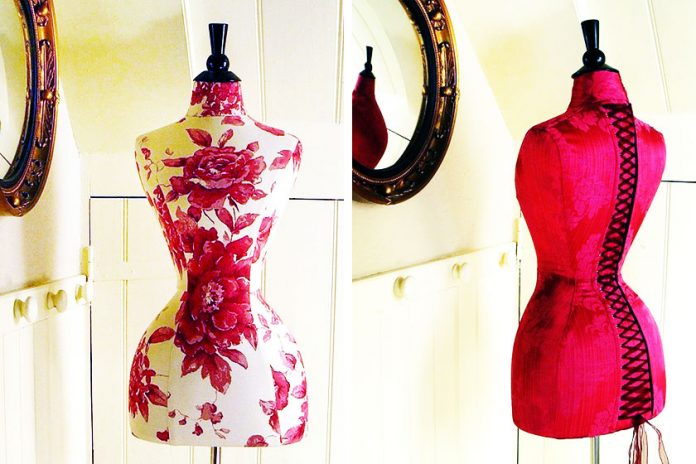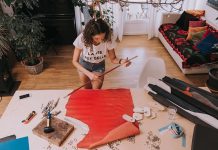If you are tired of paying out for expensive, custom-made dress forms, then have you ever thought about how to make your own dress form? DIY dress forms are becoming more and more popular due to the amount of money they enable you to save. So, if you can spare a little time and effort, and can find yourself a pair of helping hands, then a homemade dress form could be perfect for you.
You may be a complete dress making pro or you might be a complete newbie. So, for those of you who aren’t familiar with this piece of kit, let’s just briefly explain what a dress form is and why you might use one.
A dress form itself is a life-size, 3D model of the body, the torso area in particular. Its purpose is to assist with sizing and fitting of clothes that you may be designing and making. As you go through the process of making your garment, you can place it on the dress form to check how it fits and hangs or flows, for example. A properly made dress form will be of great use to ensure correct sizing and that adjustments can be made in good faith.
Now you realize how handy a dress form can be, it’s time to know how to make your own dress form. Some of the methods are quick and easy, whereas others will take more time and patience.
(Also see our 25 Unique Gift Ideas for Women)
How to make a duct tape dress form:

This type of form is quick and easy to make and is fairly inexpensive.
You will need:
A willing model, a long t-shirt for them, plenty of duct tape, scissors, plastic wrap, thick black pen
Process:
Have your model stand comfortably, wearing the long t-shirt you have provided. You will initially need to start wrapping the duct tape crossways from the bottom of the t-shirt, which should be somewhere around the mid-thigh area. The aim is to wrap the duct tape fairly close to the body but not to squeeze against it. This process will involve layering, so on the initial layer go easy around the waist and do not pull the tape too tight.
On reaching the chest and underarm area, you may need to make adjustments to the t-shirt in order to follow the line properly and do use smaller pieces of tape to place carefully around the breast area.
At this stage, you will be nearing the neck area, cover and protect this area with plastic wrap and then continue to duct tape around the neck and arm areas to provide a fitted shape similar to that of a bustier.
This whole wrapping process will now need to be repeated twice more, the second layer should run top to bottom and the third layer across as per the first.
Once all three layers are complete, it is a good time to grab your black pen and mark out the models’ waistline before it is too late. In order to remove the newly made form, take your scissors and make an opening, including form and t-shirt, in the middle of the back of the form. It is advisable to be careful at this stage not to cut your models’ own clothes or inadvertently injure them with the scissors.
Once fully cut off and removed, stick the form back together again with more duct tape ready for stuffing and maybe placing on a stand.
How to make a paper mache dress form that is taped:

Source: Makingitwell
Reams of brown paper tape from an office supply store and a willing model provide a cost effect and easy way to make this DIY dress form.
You will need:
Brown paper tape, wet sponge, a willing model, a t-shirt or similar garment for them to wear, hairdryer
Process:
Be sure to start working in an area that is suitable since the use of a damp sponge may create some unwanted wet mess. Have your model stand in a comfortable position wearing the t-shirt that you have provided. Have some strips of brown tape at the ready, and once you have moistened them with the sponge, start to wrap them around the model fairly tightly. It is best to start at the bottom them move to the top, omitting the bust area for now. Once the top and bottom are complete, take some smaller strips of brown tape and arrange them around the bust area. The neck and arm areas should be tackled next, with wrapping taking the shape of a traditional bodice. Once you have your first layer complete, you should continue to repeat to a maximum of four layers, do change between wrapping across and then up to down for strength. It is advisable once complete, to dry off your paper tape form with the hairdryer, or your models’ legs may tire from standing for a long period of time. Once the form is fairly dry, it is time to carefully cut it away from the model down the center of the back. The form should be taped together again once removed, ready for stuffing.
How to make a molded papier mache dress form:

If you are looking for a much more accurate dress form then you should definitely go down this route using papier mache. Although a little fiddly and more expensive, you will definitely benefit from the finished product.
You will need:
Plaster of Paris, paper pulp insulation, wallpaper paste, large mixing bowl, plastic wrap, paper towels, hairdryer, white glue, cord, small wooden splints, knit fabric, willing model, tight t-shirt or black bin liner to be used as undergarment
Process:
Your model will need to be stood in a very comfortable position in a well-covered area. This process may take some time and will be very messy. At this point, you are ready to start the wrapping process, so ensure you have your plaster of Paris strips wet and at the ready.
Using similar processes to before, start by wrapping the models’ torso from bottom to top in a sideways direction, ensure you protect the neck area with the plastic wrapping. Use smaller strips for the bust area and pay good attention to the sleeve area also. The wrapping process should be carried out as a repeat process to create a good thickness.
Whilst still damp enough to cut, you should remove the plaster form from the model but cutting down each side, as opposed to down the back as before. At this point, prepare the mache by mixing the paper pulp insulation with the wallpaper paste in a large bowl.
Lay out the two halves of the mold and lay paper towels inside to prevent the mache becoming attached once applied. Take your mixture and gradually start building up inside the form using a layering process. You should make the edges a little wider than they are currently to enable you to stick the halves back together again.
When both halves are pretty much full, take a hairdryer and give them a blast to quicken the drying process. You will now need your glue to stick the two halves together, applying lots to the edges to give good hold, now take your cord and tie the mold together so that it dries shut.
Do keep an eye on things as the drying process takes place, in the event that the cord starts to loosen, you may need to grab your wooden splints and slot between the cord and mold to tighten things up again. Once drying is complete, remove the splints and cord and cover your form with a knit type material as this will be easier to pin to than the solid mache. Create a stand for your form and you will have a really professional looking custom mannequin.
(Also see How to Buy the Right Sewing Machine)
How to make your own dress form with foam:

As with the papier mache option, this dress form process is on the expensive side but provides much greater accuracy when it comes to designing and fitting garments. You will have your very own shop window mannequin. Watch out though as this one is super messy.
You will need:
Plaster of Paris, mixing bowl, willing models with t-shirt undergarment, scissors expandable foam, lubricant, protective clothing and goggles, knit fabric
Process:
As with the papier mache option, you will first need to wrap your model using the plaster of Paris process. Once all layers are complete, remove the cast by cutting down the sides and secure together again using further papier mache strips.
Now comes the fun part, clad in your protective clothing and goggles, place your mold in a clear area to start work with the foam. Prepare the inside of your mold with the lubricant to stop the foam from sticking once it sets.
Take the can of foam and start to build up even layers inside your mold. Do be aware that this foam does expand, so do no fill to quickly and leave resting time between each layer to ensure that you do not overfill. Once you have your mold filled, tidy away your materials and leave to set overnight.
When you return to your mold you should now be in a position to cut and peel it away from the foam in order to reveal your dress form. As with the papier mache form, do continue to cover with knit type fabric as this will aid pinning as the foam will be too dense. Most would create a holder for the form at the point to create a mannequin structure. This form will enable design of great custom-made garments.
(Also see How to Buy the Right Embroidery Machine)
How to pad a dress form:

Dress forms are, more often than not, solid entities that do not truly represent the female body, or male body for that matter. Bust and bottom areas will be pert and in need of no support and this is just not how it is in real life.
It is, therefore, good practice to know how to pad out your dress form to represent the true shape of your client or model. In order to pad out breast and bottom areas properly, you should take good measurements of your model and make a note of the findings. If the breast area is larger than your dress form then you will need a standard bra and pin this neatly to the form. You are now at a point where you can pad out the bra to better resemble the shape of your model.
Padding can be easily made using dried sundries of some sort, such as rice or smaller grains. Create different sizes of padding by placing the dried goods into sealable plastic packets. These can then be slotted into the bra to take the shape of your model. You may want to top up the bra area with soft padding also to create a smoother finish.
A similar process can be used for the hip and buttock area to create a curvier shape. Create several packets of different sizes using the dried goods and use plastic wrap to attach to the required areas. You can again use softer materials to smooth out areas where required. Although time-consuming, it is much more accurate to work with your dress form in this way as it will ensure a good garment fit for your clients.
As with any creative task, it is always useful to ensure you have the correct materials in hand to make your dress form. Take your time to find quality materials and ensure you have enough, running out towards the end would be heart-breaking after all of the efforts you will have made. Although it is possible to carry these processes solo, it would be really useful to enlist the help of a friend, or enemy, to be your wrapping buddy. Provide them with refreshments and something to watch to ensure they are entertained throughout what can be a lengthy process.
Be aware that although some of the methods are quick and easy, some are more time-consuming and can be very messy. Please do ensure that you protect clothing that needs to be preserved and cover workspaces well to prevent damage. Ensure you always take removing of the mold or form very seriously and scissors can cause harm to your model if used inappropriately.
As you can see, making a dress form at home can be a fun and cost-effective way to create great fitting garments. Whether you are just starting out or want the highly accurate and shapely fit, there are options to suit every ability and budget. Now that you know how to make your own dress form, you can save a lot of money with your DIY dress forms.
 Home
Home Sewing, Embroidery & Serger
Sewing, Embroidery & Serger Cutting machines
Cutting machines Brands
Brands Review
Review





































